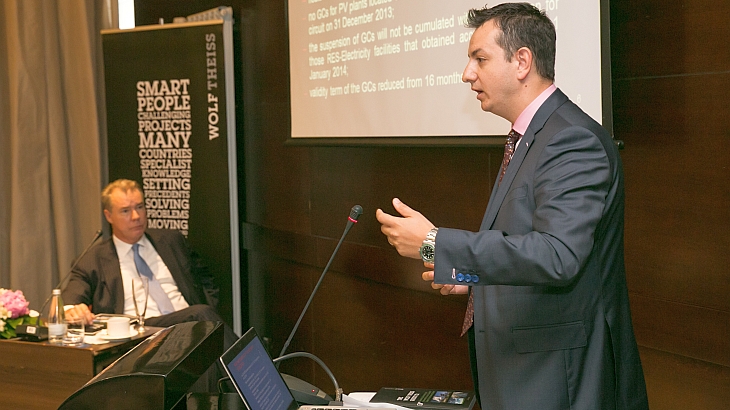Wolf Theiss released the fifth edition of its flagship publication, The Wolf Theiss Guide to: Generating Electricity from Renewable Sources in Central, Eastern & Southeastern Europe (RES Guide). The RES Guide brings an updated insight into the laws and regulations pertinent to the region’s future renewable energy development and alternative ways of generating electricity. The launching event was a good opportunity for an in-depth analysis of the current situation of the sector in Romania, where the recent changes in legislation, regulation and authorities’ attitude have drasticaly affected this industry forecasts.
There’s nothing like 3 years ago
Bryan Jardine, the Wolf Theiss partner heading the firm’s Renewable Energy Working Group acknowledged that some of the region’s important markets, including Romania, have suffered some serious regulatory set-backs. So that the current situation is nothing liken the one captured in the 2010 or 2011 RES guide editions. The laws and regulations pertinent 3-4 years ago lured a large number of companies in Romania, which resulted into a stunning 40% of Romanian FDI, in 2012, to originate in RES projects.
For now, recent changes in legislation and regulation of the sector of electricity production from renewable resources are each and every one a new blow against its perspectives:
- suspension from July 1, 2013, to March 31, 2017, of a number of GCs for new hydro, wind and solar
- implementation of annual overcompensation analysis of the RES-electricity market
- interdiction of the GCPA’s outside the centralized market for GCs
- floatable RES-Electricity quota starting with 2014
- validity term of the GCs reduced from 16 months to 12 months
It is also aknowledged that the Romanian setback is not unique in the EU. In Bulgaria there was applied a new fee for the connection to the national grid, while Poland has not yet decided how its support scheme will work.
6 years ahead of the schedule
Valeriu Bining, Director, Financial Advisory at Deloitte Romania, pointed out that the uncertainty of the last year contributed – paradoxically – to an accelerated development of renewable Romanian sector. The result is that Romania is now among the few European countries most advanced in achieving the common goal of a 20% green energy share in the total national production of primary energy resources. According to Binig, this leading position is not safe at all; the change of attitude from the authorities side could reverse this trend, with the bleak perspective that Romania will not meet its obligations in 2020, although it does now.
One question – the most important – remains without a clear answer: is it worth to invest in the Romanian renewable industry? Valeriu Binig believes that it takes a lot of courage, financial strength and long-term vision to start or to support projects in the renewable sector. “Romania’s economy will eventually return to re-industrialization and with it, a higher demand for electricity. The role of renewable energy and its price will rise; those who invest now, will be in better positions to ripe the benefits”.
However, the existing investors have very limited options. One is to leave the market by selling their assets, at a time when buyers are hard to find. Most of them will probably try to wait for better times, recovering their investments in longer periods of time, while securing renegotiated contracts with the banks.
According to Ciprian Glodeanu, partner at Wolf Theiss Romania, although prospects are still unclear, there are still investors willing to bet on the future of local renewable market. They focus on the untapped potential in conditions where opportunities are becoming more and more limited in the mature markets of the European Union.
a
 Guide to: Generating Electricity from Renewable Sources in Central, Eastern & Southeastern Europe (RES Guide)
Guide to: Generating Electricity from Renewable Sources in Central, Eastern & Southeastern Europe (RES Guide)
Since the publication of its first edition, in 2009, the RES Guide has brought an important contribution to consolidating Wolf Theiss as a professional and successful expert in the renewable energy sector for this fast evolving Central, Eastern and Southeastern European region.
In the first part of the Guide, Wolf Theiss presents an executive summary outlining the current regulatory framework applicable in each of the 15 jurisdictions. The second chapter of the Guide contains an outline of the main forces driving the development of RES-Electricity in the region. The regulatory framework applicable in each jurisdiction is described in more detail in the country chapters which follow a uniform structure to facilitate cross-referencing.
